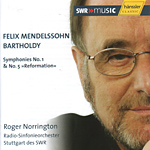Of Mendelssohn’s five symphonies, the First responds best to Roger Norrington’s period-based approach. It’s the lightest and also the smallest-scaled, well suited to the reduced instrumental forces (around 40 players, as was done in Mendelssohn’s time). Norrington employs brisk tempos and crisp phrasing, and he keeps rhythms tightly controlled. In his included talk, the conductor makes much of Mendelssohn’s taking the lead of Mozart rather than Beethoven. And indeed, this performance makes the work sound a good deal like Mozart’s Symphony No. 40.
Symphony No. 5 is more difficult to bring off, and Norrington’s “authentic” aesthetic, with its eschewing of vibrato, doesn’t help matters: the strings sound pale and undernourished (this despite the orchestra’s doubling in size to “festival” proportions). The moderately-paced first movement proceeds well enough, as does the slow movement. But a quick listen to Bernstein’s Israel Philharmonic performance reveals the passion that’s missing from Norrington’s rendition. This is especially the case in the finale, where Norrington’s matter-of-fact manner in the closing peroration sounds inert next to Bernstein’s gleaming triumph. The Stuttgart Radio Symphony plays handsomely, even under restricted circumstances. Hänssler’s live recording is bright and clear, though a little bass-shy–an aspect most likely due to the conductor’s peculiar ensemble balance. So, unless you are a period-performance specialist, you really aren’t missing much here.
































